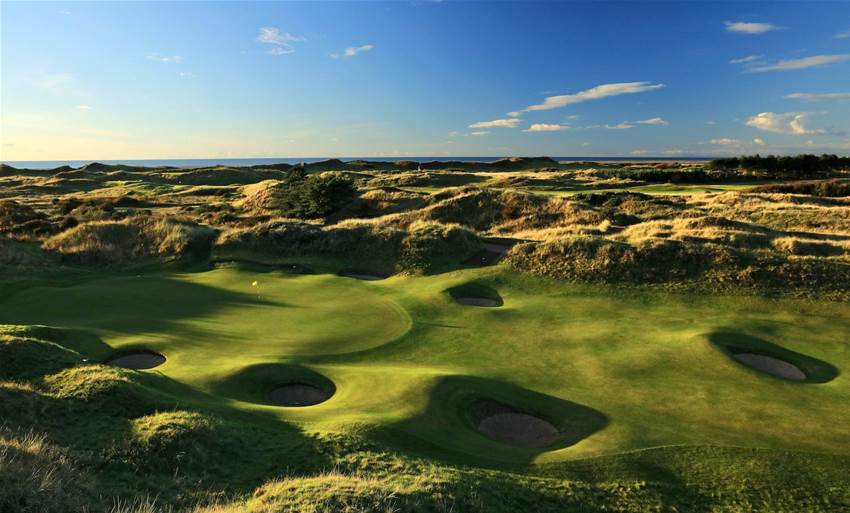Royal Birkdale “is tough but fair”. That’s the general consensus among the players ahead of the first round of 146th Open Championship.
The Open returns to the Southport links for the first time since 2008 when Padraig Harrington successfully defended his title won at Carnoustie.
Not much has been changed to the layout since Harrington’s victory. Some bunkers have been re-shaped or slightly moved, while the layout will ply 17 yards shorter than it did nine years ago.
The warm conditions on the English north west coast during the past few weeks have Royal Birkdale playing firm and fast and the players couldn’t be happier.
 “All the areas, all the seaside towns we play, they're all fantastic, they all have a great charm about them,” says Justin Rose.
“All the areas, all the seaside towns we play, they're all fantastic, they all have a great charm about them,” says Justin Rose.
“But for me the charm about this one is the golf course. I love it. I think it's the fairest links golf course we play. It rewards great golf.
RIGHT: Justin Rose has a laugh during his Wednesday practice round. PHOTO: Andy Buchanan/AFP/Getty Images.
“The bounce, the vagaries of the bounces are slightly less in play here than at some other golf courses we play in the rotation.
“But we really haven't played this course in good weather, virtually everybody here hasn't played it in good weather. '98 wasn't great. '08 wasn't great. This week might not be great. Because it's a fair golf course, I think it plays well in tough conditions, too.”
Jordan Spieth said the set-up of the course, particularly how the rough was cut, impressed him.
“I think part of it (the fairness of the course) is the graduating rough,” he said.
“They've done just a phenomenal job here of – areas where with the winds that we're going to have, if it's very difficult to hold a fairway, if you hit a really good shot and it creeps into the rough, there's very little rough, you're still fine.
“You get rewarded for a really good shot. And then it's graduated rough. The further off line you hit it, for the most part out here, the more trouble you're going to be in.

“There’s a lot of crosswinds, which makes it really tough to hit fairways, but a good shot is still going to reward you. Really well-placed bunkers, ones where on some holes if you want to fly the short ones, instead of hitting iron off the tee, it's going to be very difficult for you to fly them but leave them short of the next set of bunkers.
“There’s a lot of risk/reward options off the tee out here, and if you choose for the risky, and you still hit a good shot, it really will reward you.”
Here are the six holes that will be front and centre in determining who is named the Champion Golfer of The Year in 2017.
1st hole. 448-yard, par-4
Royal Birkdale’s opening hole has been the second most difficult hole on the course in each of its last two Championships in 1998 and 2008.
The dogleg left fairway sweeps past a bunker cut deep into a dune just left of the driving zone. Closer to the green, the fairway veers right around mound partially obscuring a view of the putting surface, which is protected by pot bunkers left and right.
 The 1st proved to troublesome in 2008 for Greg Norman. Leading by two, his final round got off to a bad start when he hit his approach into the front right bunker (pictured) and was unable to save his par, giving Padraig Harrington a boost. It was his third bogey on the hole in four rounds.
The 1st proved to troublesome in 2008 for Greg Norman. Leading by two, his final round got off to a bad start when he hit his approach into the front right bunker (pictured) and was unable to save his par, giving Padraig Harrington a boost. It was his third bogey on the hole in four rounds.
In 2008, there were just 23 birdies made by the field over the four days.
2nd hole. 422-yard, par-4
The 2nd hole is played into the teeth of the prevailing wind and some players will be tempted to use driver here. But accuracy is paramount as the fairway narrows between two bunkers right and a series of mounds to the left.

Missing the fairway can make it difficult to hit the green, which is guarded by six pot bunkers – one well short, two right and three to the left.
While 2008 Champion Harrington says this hole “won’t keep you awake at night” it becomes substantially more difficult if you have played the 1st hole poorly.
The average score here during the 2008 Open was 4.368, with just 26 birdies for the four rounds. American J.B Holmes won’t recall the hole fondly, after he notched up a quadruple bogey eight during the second round in 2008.
6th hole. 499-yard, par-4
This is the hole the players in this year’s Open fear the most.
It was a beast in 2008, averaging 4.765 for the Championship, and yielded just 10 birdies across the four rounds.
In fact, the sharp left-to-right dogleg has been toughest hole in each of the last two Open Championships played at Birkdale.
Players need to thread their drive between two bunkers set into each side of the landing area. Any drive finding the right bunker will almost certainly result in a bogey or worse.

Most players will head into this green from about 200 yards and club selection is crucial. The putting surface sits above the fairway and angles slightly from left-to-right. Missing the green anywhere here will leave a difficult up-and-down for par.
“Six is a big challenge,” says Jordan Spieth. “I think we're going to get the wind off the right and into, which makes the tee ball a little easier for a right-hander.
“I hit driver yesterday and I hit 3-wood today, both good shots and I had 6-iron and 5-iron in in two days. But, yeah, if you hit a good tee ball, you've got a long iron in and around the greens, as long as you're not in those first two pot bunkers, you can make a four. It's really in the tee shot.”
Despite his high finish, Greg Norman played the 6th hole in four over, making just one par here, in the 2008 Open.
15th hole. 542-yard, par-5
The first of Birkdale’s two par-5s is the second easiest hole on the course and provides the ideal opportunity to turn a poor round into a solid round, or a good round into an even better one.

But this hole should not be taken for granted. There are thirteen bunkers lining the fairway here and that doesn’t include the two sitting either side of the green. The closer you get to the green the deeper the bunkers get and the easier it becomes to post a big number should you find one of them. Peter Fowler made that discovery in 2008 when he notched up a 10 en route to missing cut.
17th hole. 567-yard, par-5
Large sand dunes left and right of the driving area must be avoided, likewise the two hidden bunkers that lie to the right of the fairway between 310 and 325 yards from the tee. The tee shot needs to carry two large sand dunes situated to the left and right of the fairway and avoid two bunkers hidden down the right-hand side of the fairway 312 and 323 yards from the tee.
Three bunkers guard the narrow and dramatically sloping green, adding some risk to any player aiming to find the green in two shots. The bunker cut into the right edge of the putting surface has been moved marginally since the 2008 Open, while a series of swales can now be found at the rear of three green.

Of course, it was here in 2008 that Harrington sealed his victory with his now famous 5-wood that settled just three feet from the hole and set up an eagle to increase his lead by four strokes with a hole to play.
 RIGHT: Padraig Harrington makes his eagle putt to extend his lead four shots in 2008. PHOTO: Getty Images.
RIGHT: Padraig Harrington makes his eagle putt to extend his lead four shots in 2008. PHOTO: Getty Images.
“There are bunkers placed around the green so it’s a strategic shot but the beauty is that if you take it on and hit a good shot, you will finish pretty close to the green set into some sand dunes, providing a great chance for birdie or eagle,” Harrington says.
18th hole. 473-yard, par-4
A difficult par-4 to finish, with out-of-bounds down the right of the dogleg right fairway. There’s a fairway bunker left and a smaller, and arguably more penal, pot bunker to be found at the 300-yard mark down the right. If the biggest hitters in the field elect to take these traps out play, there is another bunker lying in wait at the 349-yard mark.
The three bunkers lining the front half of the green are easily found with mis-hit approach shots and they are shaped to make any escape a difficult one.
“I really like the finishing hole,” said Marc Leishman, who nailed a short iron to eight feet here during his Monday practice round.
Related Articles

Record win leads to major invites in Hong Kong for McKibbin

Play your own game at Kauri Cliffs













